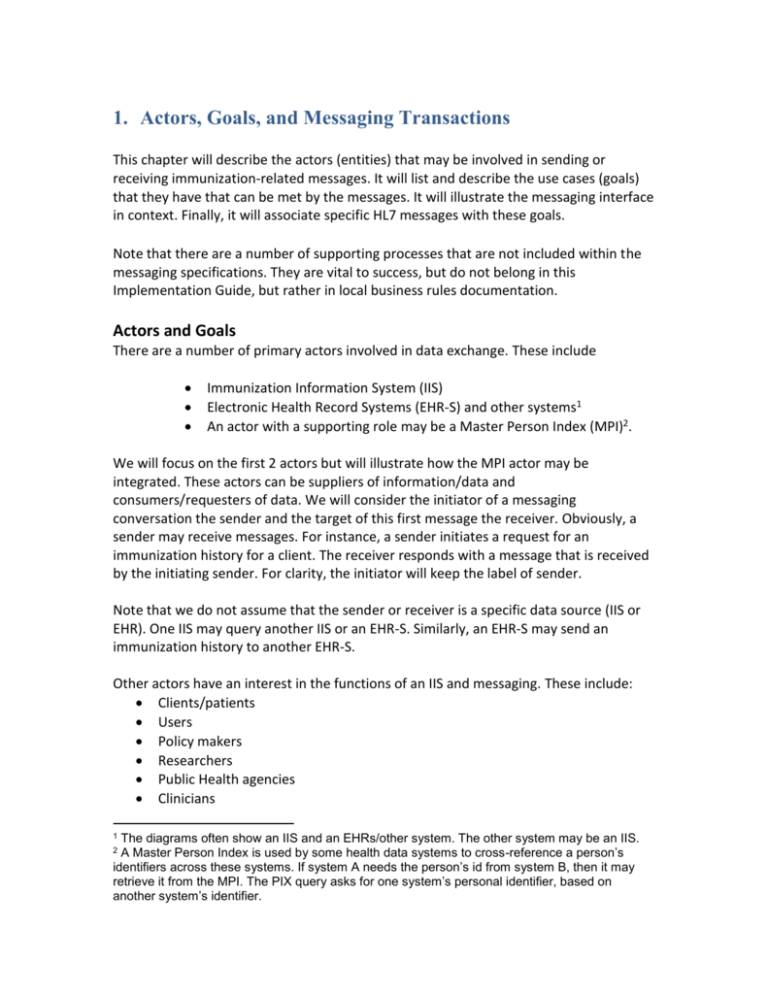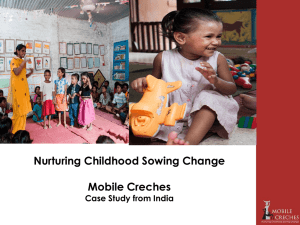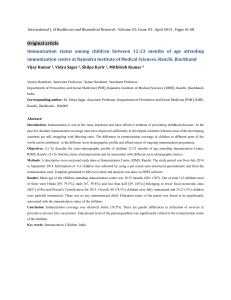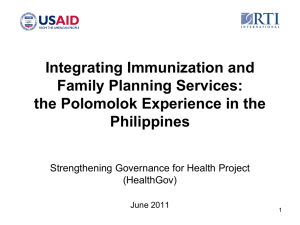Chapter 2 from V2.5.1 Implementation Guide for Immunization
advertisement

1. Actors, Goals, and Messaging Transactions This chapter will describe the actors (entities) that may be involved in sending or receiving immunization-related messages. It will list and describe the use cases (goals) that they have that can be met by the messages. It will illustrate the messaging interface in context. Finally, it will associate specific HL7 messages with these goals. Note that there are a number of supporting processes that are not included within the messaging specifications. They are vital to success, but do not belong in this Implementation Guide, but rather in local business rules documentation. Actors and Goals There are a number of primary actors involved in data exchange. These include Immunization Information System (IIS) Electronic Health Record Systems (EHR-S) and other systems1 An actor with a supporting role may be a Master Person Index (MPI)2. We will focus on the first 2 actors but will illustrate how the MPI actor may be integrated. These actors can be suppliers of information/data and consumers/requesters of data. We will consider the initiator of a messaging conversation the sender and the target of this first message the receiver. Obviously, a sender may receive messages. For instance, a sender initiates a request for an immunization history for a client. The receiver responds with a message that is received by the initiating sender. For clarity, the initiator will keep the label of sender. Note that we do not assume that the sender or receiver is a specific data source (IIS or EHR). One IIS may query another IIS or an EHR-S. Similarly, an EHR-S may send an immunization history to another EHR-S. Other actors have an interest in the functions of an IIS and messaging. These include: Clients/patients Users Policy makers Researchers Public Health agencies Clinicians 1 The diagrams often show an IIS and an EHRs/other system. The other system may be an IIS. A Master Person Index is used by some health data systems to cross-reference a person’s identifiers across these systems. If system A needs the person’s id from system B, then it may retrieve it from the MPI. The PIX query asks for one system’s personal identifier, based on another system’s identifier. 2 Billing systems These actors will not be directly addressed in this Guide. They interact with the primary actors to accomplish their needs. Table 1-1 Actors and Goals for Messaging Actor Immunization Information System (IIS) Responsibility Provide access to a complete, consolidated immunization record for each person in its catchment area Messaging Goals Receive immunization histories and updates Supply individual immunization records to authorized users and systems Receive requests for individual records Support aggregate reporting and analysis Evaluate immunization history and make recommendations for next doses Store medical conditions that affect what vaccines are recommended Receive demographic updates Receive observations about a person Send observations about a person Send immunization records to other systems Send demographic data Request immunization record Request person id Acknowledge receipt of message Report processing errors from receipt of message Actor Electronic Health Record system (EHRS) Responsibility House a person’s electronic health record Messaging Goals Receive immunization histories and updates Make a person’s record available to authorized persons Receive demographic updates Provide decision support for clinical decisions. Receive requests for individual records Send immunization records to IIS Send demographic data Receive observations about a person Send observations about a person Request Immunization record Request person id Acknowledge receipt of message Report processing errors from receipt of message Request evaluation on an immunization history and recommendations for next dose on a given Schedule, such as ACIP Actor Master Person Index or other identity broker. Responsibility Maintain a list of patients and identifiers for a set of persons Messaging Goals Send id for an individual for use in a record request or record update Supply identifiers for other system’s use Receive request for person id. Be a central demographic supplier for participating systems Return complete demographic data for an individual from central demographic store Provide cross-reference for identifiers for participating systems. The table lists a number of messaging needs that relate to IIS and their trading partners. These are all candidates for HL7 messaging. Some are not currently implemented, but give us the landscape that should be considered. Note that the messaging for maintaining of an MPI is out of scope for this Implementation Guide. Another way to organize these tasks or goals is to decompose the goals of the entities (actors) into the various roles they may play. These roles include: Immunization history supplier Immunization history consumer Demographic information supplier Demographic information consumer Identity resolution broker Each of the actors above may have the capacity and interest to support some constellation of these roles. This approach is useful for system design and implementation and encourages a services approach to development. Since the goal of this chapter is to provide a non-technical view to help system managers understand how messaging can meet their needs, we will focus on the business entities and their goals. High-Level View of Use Cases We can map these actors and messaging goals to use cases. The following diagram maps the messaging goals of the various players to use cases. These use cases will be defined below. Note that some of these use cases are logically related. For instance, Request Immunization History is paired with Return Immunization History. Send Immunization History needs the receiver to Receive Immunization History. These use cases are not intended to be the basis of a software design process. Several paths may accomplish the request for immunization history. Systems will return an immunization history when they are confident that the person requested has been identified. One path separates identity resolution from the request for immunization history. Another includes implicit identity resolution. For details, see use case 3, 4A and 4 below. Figure 1-1 Use Case Diagram The following diagram illustrates a more detailed view of the request immunization history and return immunization history. It breaks the Find Candidate Clients use case out. Note that a system may request identity resolution (find client) prior to requesting an immunization history. Alternatively, a system may request an immunization history. This can trigger an implicit request to find a client. Figure 1-2 Finding a Client The following lists the HL7 Messages shown below in the Use Cases: ACK-Acknowledgement message ADT-Admit, Discharge and Transfer message QBP-Query by parameter RSP-Respond to QBP VXU-Unsolicited vaccine history The following are profiled queries supported by IHE for identity resolution: PDQ-A specific type of QBP that facilitates identify resolution based on demographic information PIX- A specific type of QBP that accomplishes id cross reference Use Case Descriptions Use Case 1—Send Immunization History Goal: To send an immunization history for an individual client from one system to another. In addition to EHR-S and IIS, other systems such as vital records systems or billing systems could use this message to send immunization histories. HL7 version 2.5.1 Message Type: VXU Precondition: A user or other actor requests that the sending system send an immunization history. Figure 1-3-Use Cases 1 and 2: Send and Receive Immunization History This sequence diagram illustrates the message flow. The sender sends an immunization record (Use Case 1). The receiver accepts the message (Use Case 2) and processes it. The receiver may send an acknowledgment message. (See Use Case 9) The transactions that are of interest are indicated by bold arrows. Use Case 2—Receive Immunization History Goal: To receive an unsolicited immunization history. It may be an update or a new record. This use case does not have responsibility for the processing of the message. The receiving system may review and accept the immunization history if it chooses, but this outside the scope of this use case. HL7 version 2.5.1 Message Type: VXU Precondition: A VXU is received by the receiving system. Use Case 3—Request Immunization History Goal: To request an immunization history from another system. Precondition: A user or other actor requests that the sending system send a request for an immunization history using demographic information and/or other identifiers. The old VXQ query included implicit identity resolution. If a high confidence candidate was identified, based on demographics and other identifiers, an immunization history was returned in a VXR. If lower confidence candidates were found, a list of candidates was returned for further selection in a VXX. The selection from the VXX informed the requery with a new VXQ. The approach outlined in this Guide allows this process to be followed using different messages. Another approach that is common in the informatics world is to separate the identity resolution from the request for content (immunization history in this case). Here the requester sends a query seeking a candidate, based on demographics and other identifiers. The requester selects from the candidates returned and then sends the request for content based on that selection. The identity may be sought from a separate Master Person Index or from the content provider. One industry standard, which supports this approach, is the PDQ query profile by Integrating the Healthcare Enterprise (IHE). The approach outlined in this Guide allows this process to be followed. A third situation occurs when the requester already knows an identifier meaningful to the responding system. This may occur when the sending system has already sent a record for the person of interest that includes the sender’s identifier. Alternatively, it may occur if the requester knows the unique identifier used by the responding system. The approach outlined in this Guide allows this process to be followed. Since identity resolution is required either implicitly or explicitly, a use case is described for finding a client/candidate (Use Case 4A). That use case contains the alternate flows for the different paths. Note that more detailed information about the flow of events and options is available in Appendix B. HL7 version 2.5.1 Message Type: QBP using Request Immunization History query profile. Figure 1-4-Use Cases 3, 4 and 5: Request Immunization History, Respond to Request and Accept Requested History Note that the sending system process may include confirming that the record returned is the one being sought. This process is not specified here. Use Case 4—Return Immunization History Goal: To return an immunization history. It does not include the processes used to find candidate clients for return. There are 4 possible results: 1. One client matches exactly3 the criteria sent 2. One or more clients match the criteria sent (inexact match)4 3. No clients match the criteria sent 4. There were errors or other problems Note that systems must deal with the situation where a Client has indicated that his/her records must be protected. (Only the owning provider may view) This should be clearly documented. See Figure 2-6. Standard Reference HL7 version 2.5.1 Message Type: RSP Precondition: A receiving system receives a request for an immunization history. The definition of “exact” is a local business rule and should be documented locally. If more than one client has a high-confidence match with the query parameters, this is an inexact match. 3 4 HL7 version 2.5.1 Message Type: QBP using Request Immunization History query profile Use Case 4A—Find Candidate Clients Goal: To find one or more candidate clients from another system and select one to be used when requesting an immunization history. Precondition: There are two potential preconditions. 1. A user or other actor requests that the sending system send a request for one or more candidate clients using demographic information and/or other identifiers. (This is well specified in the IHE PDQ profile) 2. A receiving system receives a request for immunization history using a request for immunization history query. If exactly one high confidence match is found then an immunization history is returned. If this query does not find one high confidence candidate, but rather finds one or more lower confidence candidates then a list of candidates are returned. If more than one high confident match is found, then this is treated as a lower confidence match. Note that the diagrams below are intended to put the messages in context and do not accurately reflect the architecture that would support the activities. Request Identity Resolution Prior to Requesting an Immunization History The following diagram illustrates the process and messages where a system uses a PDQ query to request identifiers and demographics for a client. The result of this process is then used to populate a Request for Immunization History query. Messages have bolded arrows. Other processes are not bolded. It should be noted that the immunization history supplier may also act as the id supplier, but this is not required. This particular Use Case focuses on the interactions between the requester and the id supplier. The other transactions illustrate how this fits into the rest of the process. We assume that the identifier used in the QBP^Q11 is unique within the immunization history supplier. Figure 1-5--Using PDQ to Resolve Identity Prior to Request for Immunization History Requesting an Immunization History Using Implicit Identity Resolution The following 2 diagrams illustrate how a system, which uses a Request for Immunization History, relies on implicit identity resolution. The first drawing illustrates the case when one high confidence candidate is found. The outcome of the find client process is a call for the system to send the immunization history back to the requesting system. Messages are bolded. Figure 1-6--Implicit Identity Resolution in Response to a Request for Immunization History When One High-confidence Match Is Found When the find client process finds lower confidence candidates, then the system returns a list of candidate clients. The user reviews these and selects the one of interest. The selection is used to populate a second Request for Immunization History query. The identity resolution process points to the correct client and an immunization history is returned. The user may choose to refine the search criteria and submit a new query, if he/she believes that a match should have been found. Figure 1-7--Implicit Identity Resolution in Response to a Request for Immunization History When Lower Confidence Candidates Are Found HL7 version 2.5.1 Message Type: QBP using Request Immunization History query profile Or QBP using PDQ (IHE) Use Case 5--Accept requested history: Scope: The goal of this use case is to accept an immunization history in response to a query for an immunization history from another system. Standard Reference HL7 version 2.5 Message Type: RSP Preconditions: A sending system receives a requested immunization history. Sequence Diagram: See sequence diagrams for use case 3 above. Use Case 6—Send Demographic Data Goal: To send demographic data about a person. It may be an update or a new record. This use case does not have responsibility for the processing of the message. The message will include an indication of the expected/requested acknowledgement. Standard Reference HL7 version 2.5 Message Type: The standard messages that may be used for carrying demographic data are VXU and ADT. Precondition: A user or other actor requests that the sending system send demographic data. Sequence Diagram: See Figure 2.7. Use Case 7—Accept Demographic Data Goal: To accept demographic data about a person. It may be an update or a new record. This use case does not have responsibility for the processing of the message. The message will include an indication of the expected/requested acknowledgement. Standard Reference HL7 version 2.5 Message Type: The standard messages that may be used for carrying demographic data are VXU, ADT. Precondition: The receiving system receives demographic data. Sequence Diagram: See Figure 2-7. Figure 1-8--Send Demographic Data Via VXU or ADT Use Case 8--Acknowledge Receipt Scope: The goal of this use case is to acknowledge receipt of a message. This can be an immunization history, request for immunization history, demographic update, observation report or request for personal id. It may indicate success or failure. It may include error messages. One example occurs when a query is well-formed, but finds no candidates. In this case the acknowledgement reports this fact. Standard Reference HL7 version 2.5 Message Type: ACK, RSP Precondition: A system has processed a message and determined the success of receipt. Sequence Diagram: See sequence diagrams for use cases above. Use Case 9—Report Error Scope: The goal of this use case is to send error messages related to messages. These errors could result of rejection of message or parts of message. Standard Reference HL7 version 2.5 Message Type: ACK, RSP Precondition: A system has processed a message and found errors. Sequence Diagram: See sequence diagrams for use cases above. Messaging in the Context of the Business Process While this document focuses on the format and content of messages from one system to another, it is useful to understand where this fits into the bigger picture of interoperable communication. The following diagram illustrates the most common message exchange in the IIS context, the VXU (unsolicited immunization record). When the sending system wishes to send a VXU to a receiving system, it must do several steps in preparation: o Create message5 o Assemble data on person of interest o Build the VXU message with this data o Send the message o Connect to the receiving system. The partners must agree on how this is done. o The sending system now sends the message over the connection and the receiving system catches the message. The receiver accomplishes the following steps: o Process the received message o Determine that the message is in the appropriate format. o Parse the message into a format that it uses. o Evaluate the message components to determine that these are correctly formatted and specified. o Send an acknowledgement to the sender, indicating the message has been successfully processed. Identifying which client’s record to send is an important consideration, but outside the scope of this document. 5 o Integrate the received record into the existing data base.6 o Deduplicate on client to be sure that each client only has one record. o Deduplicate the events (immunizations, for instance). o Insert or update data. Obviously, the interaction may be more complex than this7. The connection may be rejected or fail. The message may be poorly formed or may not contain required information. Part of the message may contain errors, but these errors are not sufficient to reject the entire message. The business rules for both the sender and the receiver should be clearly specified so that each side understands how the message will be handled. When illustrating the processes involved in each message below, we will not elaborate on the processes that occur outside the actual message exchange. 6 7 Local business rules determine how this occurs and should be documented clearly. See Appendix B for illustrations of the processing rules expected when handling HL7 messages. Figure 1-9--VXU Process Model Note: It is vital that each implementation clearly document the business rules and special handling in a local Implementation Guide or Profile. Local implementers may place further constraints on the specifications found in this Guide. Optional fields or required fields that are allowed to be empty in this Guide may be made required. Repeating fields may be constrained to fewer repetitions. Appendix B gives detailed example messages and has illustration of the business processes surroun






